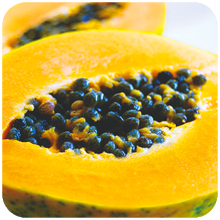
Carica Papaya is a small tree without branches, stems is in between five and ten meters in height, with spirally arranged leaves confined to the top of the trunk. Lower trunk is full of scars on the places bearing old leaves and fruits. The leaves are large, 50-70 cm in diameter, palmate 7 lobbed. The flowers are produced on the leaf axis, maturing in the form of fruits 15-45 cm long and 10-30 cm diameter. The fruit of papaya represents pear-shaped, with a green skin that turns orange when ripens. The pulp is soft, bright orange in color, sometimes pink. The seeds of the fruit are edible and black in color with spicy-bitter taste.
Chemical composition – Containing carbohydrates, fiber, calcium, phosphorus, iron, sodium, potassium, magnesium, beta-carotene, thiamine, riboflavin, niacin, ascorbic acid, vitamin E. It contains large amounts of vitamins A, K, B complex and B17 glycosides. Carpoaid glycoside and alkaloid, carpaine, pseudo-carpaine, D1-piperidine alkaloids, dehidrocarpaine I and II water. Fatty oil, volatile oil, a glycoside, caricin and enzyme myrosin. Saturated acids (palmitic, stearic, and arachidic) unsaturated acids (oleic and linoleic), bactericidal aglycone glucotropaeolin benzyl isothiocyanate, synigrin, myosin enzyme, and carpasemine. papain contained in papaya is proteolytic an enzyme, that digests proteins.
Properties – Helps stimulate the regeneration of liver cells and stimulates the secretion of bile. Soothing, antibacterial, cardiotonic, antipyretic, antihypertensive, purgative and antiparasitic Improves bowel and digestion, anti-aging and detoxifying, improves blood flow to the sexual organ.
Recommendation – Digestive disorders, constipation and bloating, emphysema, asthma, osteoarthritis and rheumatoid arthritis, macular degeneration, cardiovascular disease Systemic oxidative stress.
This plant is incorporated in natural remedy GASCURE Tablets.




